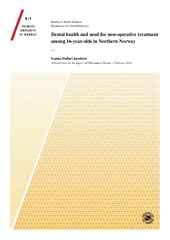Dental health and need for non-operative treatment among 16-year-olds in Northern Norway
Permanent lenke
https://hdl.handle.net/10037/12213Åpne
Thesis (PDF)
Paper I: Jacobsen, I., Eriksen, H., Espelid, I., Schmalfuss, A., Ullbro, C. & Crossner, C. (2016). Prevalence of dental caries among 16-year-olds in Troms County, Northern Norway. Also available in Swed Dent J, 40(2):191-201. (PDF)
Paper II: Jacobsen, I., Crossner, C., Eriksen, H., Espelid, I. & Ullbro, C. Need of non-operative caries treatment in 16-year-olds. (Manuscript). (PDF)
Paper III: Mulic, A., Fredriksen, Ø., Jacobsen, I., Tveit, A., Espelid, I. & Crossner, C. (2016). Dental erosion: Prevalence and severity among 16-yearold adolescents in Troms, Norway. Also available in Eur J Paediatr Dent, 17(3):197-201. (PDF)
Dato
2018-02-16Type
Doctoral thesisDoktorgradsavhandling
Forfatter
Jacobsen, Ioanna DallariSammendrag
Epidemiological data have disclosed a considerable reduction in caries prevalence among children and adolescents in Western countries including Norway for over 40 years. Concomitantly, enamel caries has received increased focus in order to give a better picture of the complete need for dental treatment, non-operative as well as operative. More recently, dental erosive wear seems to be a growing problem among the same age group.
The aims of the present thesis were:
• to determine the prevalence of dentinal caries and the variation in caries prevalence related to selected independent variables (sociodemography, lifestyle) in a sample of 869 16-year-olds from Northern Norway.
• to estimate the prevalence of proximal enamel lesions and the need for non-operative caries treatment.
• to record the quality of dental restorations.
• to study the prevalence, distribution and severity of dental erosion.
The thesis is based on an oral- and general health cross-sectional study (Fit Futures), with an attendance rate of 90%.
The DMFT/S-values were 4.2 / 6.1. The final multivariate regression analysis indicated that use of smokeless tobacco, dental fear, self-rated dental health and proximal enamel caries showed a strong independent association with prevalence of dentinal caries. Only 6 % of the 16-year-olds were completely caries-free. Eighty-four per cent of the participants presented with proximal enamel lesions. A majority of them had either previously restored teeth (35%) or both restored teeth and untreated dentinal caries lesions (34%). Over one third (35%) of the participants with fillings presented with at least one restoration below acceptable quality level. More than one third (38%) of the adolescents showed erosive wear on at least one tooth surface, either limited to the enamel (18%), or extending into the dentine (20%).
Dental caries and erosive wear are challenging conditions among North Norwegian 16-year-olds. The high prevalence of early signs of disease (proximal enamel lesions and cuppings) entails a need for non-operative treatment interventions. The DMFS-score and the high number of 16-year-olds with restorations in need of repair or replacement further indicate the importance of a non-operative treatment strategy in order to reduce the need of traditional restorative care.
Forlag
UiT The Arctic University of NorwayUiT Norges arktiske universitet
Metadata
Vis full innførselSamlinger
Copyright 2018 The Author(s)
Følgende lisensfil er knyttet til denne innførselen:


 English
English norsk
norsk
